MLA Citation Style Guide (9th ed.): Referencing & Citing with Examples
This piece of content has been developed by IvyPanda's editorial team.
No AI was involved in the creation process; only qualified experts contributed.
The information, facts, and sources presented in the text have been carefully checked and verified.
You are free to use it with proper referencing.
The MLA style is intended to be universal and apply to all forms of sources. MLA is among styles you are likely to encounter quite often. As such, this essential guide created by experienced academic writers is here to help you learn how to use it correctly.
This guide is developed in line with the MLA Handbook. 9th ed., MLA, 2021.
What is MLA?
The MLA format is named after the Modern Language Association, which has developed the standard and maintained it throughout the years. The organization is devoted to the study of languages and literature and runs a publishing program in the humanities. As such, its format is intended to be universal and can be used for many different types of paper. It is adaptable and can be applied to any variety of source, unlike other styles, which are based on specific examples. However, many sciences and disciplines prefer their formats, such as APA for medicine and Harvard for universities in general. As a result, most uses of MLA are contained in the humanities, which treat MLA as their style of choice.
The Importance of Correct Citing and Referencing
Most scholarly institutions highlight the dangers of plagiarism and the severe penalties applied for it when accepting papers. Citation styles are designed to help you avoid the act, but they also have some other benefits. For example:
- You acknowledge the contribution of others in your work, and doing so lends your paper credence. The reader can see that you have done your research and base your claims on others’ findings instead of baseless assertions.
-
You avoid plagiarism, both intentional and unintentional, by
telling yourself and others that some of the text is not your own. The reader
can see that you acknowledge the source, and you are reminded to compare your
version with the original one and ensure that you interpreted the text instead
of copying it. -
You learn to do research, find credible sources, and use them
appropriately. A reference with several authors that is published in a
scientific journal will be more reliable than a webpage whose writer is
anonymous. - You make it easier to verify the work and ensure that its contents are valid and honest. If you try to reference something the author does not say, especially in the MLA format, you will be caught and suffer the consequences.
General Principles of MLA Formatting
- Use Times New Roman 12 pt. font (unless the instructions require a different font), double-spaced.
- Set 1-inch (2.54 cm) margins (all sides).
- Page numbers have to be located in the upper-right corner.
- Last name should be in the upper-right header preceding the page
number. - MLA format does not require a title page (but one may be included if
required). - In bibliographical entries, lines other than the first one are
indented. - Use
parenthetical citations in text for bibliographical entries on the Works Cited
page. - On the first page, it is necessary to provide the MLA header in the left top corner (for papers without a title page):
MLA Title Page
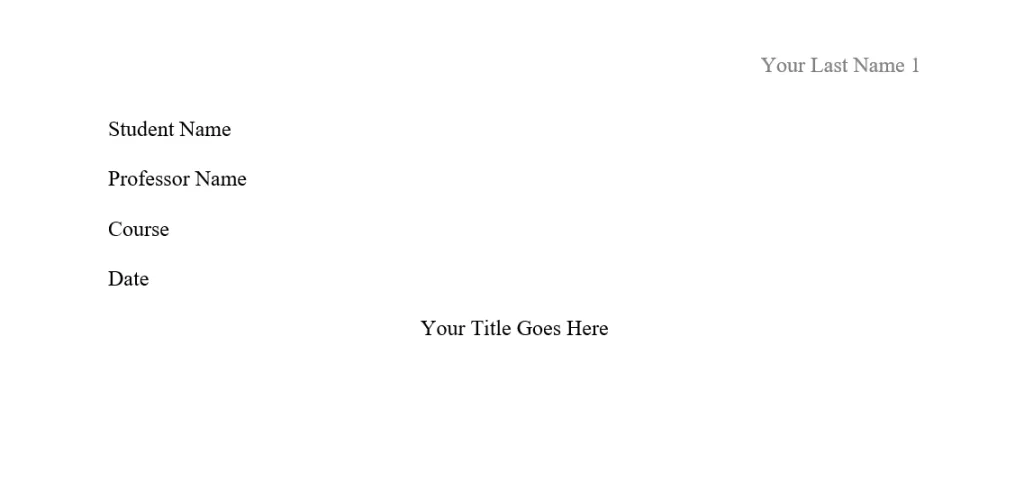
There is no specific title page in MLA style. In the upper left-hand corner of the first page, list:
- your name,
- your instructor’s name,
- the course,
- the date.
Double space between the lines. Double space again and center the title.
Write the title using Title Case (standard capitalization).
No underlining, Italics, or quotation marks should be used in the title of the paper unless you refer to some book, article, or any other work. In this case, remember a simple rule – use the same format as on the Works Cited page (for example, book titles are written in Italics, while “quotation marks are used for article titles”).
MLA Headings and Subheadings
Headings in the paper must be formatted the following way:
Level 1 Heading: Bold, Flush Left
Level 2 Heading: Flush Left
Level 3 Heading: Flush Left, Italics
MLA Outline
There are 2 basic types of outlines for you to choose (unless your tutor gives you a template)
Simple outline (either alphanumeric or decimal)
Example of alphanumeric outline
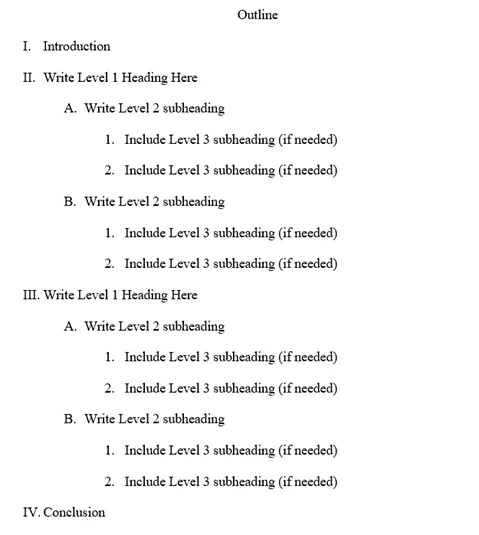
Example of decimal outline
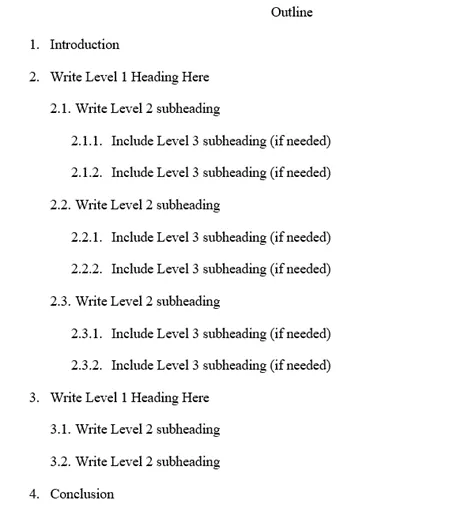
Example of full sentence outline

MLA Works Cited List
All sources used in papers written following MLA style should be mentioned under the “Works Cited” heading on a separate page. Each entry is written separately, and it consists of core elements that are included in a specific order. Some optional elements may also be added, depending on the situation.
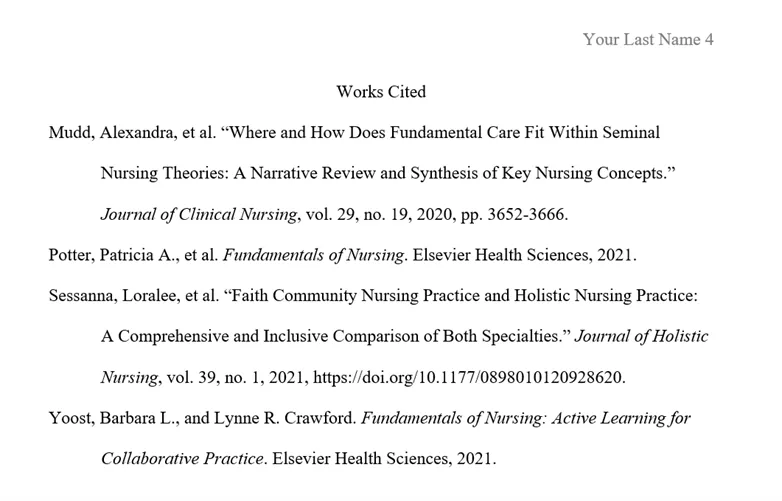
The Core Elements
Below is the list of the core elements in the order of how they should appear on a MLA reference page.
- Author. The author’s last name is followed by a comma, and all other full names as they are mentioned in the work. The element ends with a period in the reference list, such as Jameson, Carl. The in-text variant is (Jameson 44).
- Title of source. Title is the next element after the author, and it is in italics (e.g., book or journal titles) or in quotation marks, not italicized (e.g., article titles). Every word in this entry and Title of Container is capitalized apart from articles and prepositions.
- Title of container. This constituent indicates if the work was a part of a larger volume or journal.
- Other contributors. This element states other contributors. Their names are preceded by such descriptions: adapted by, directed by, edited by, illustrated by, introduction by, narrated by, performance by, translated by.
- Version. Version is commonly referred to as an edition and may appear in the reference list entry as 8th ed.
- Number. This element shows the volume used (vol. 2) or issue number of a journal (vol. 4, no. 3).
- Publisher. This information can be found on the copyright page of the source, and it shows the name of the publisher followed by a comma. When an organization is both the author and publisher of a work, the organization’s name is given only once, usually as the publisher. No author is stated.
- Publication date. This element indicates when the publication was produced (South-Western Cengage Learning, 2024). These aspects are the most common elements used in MLA citation style, but their format depends on the type of publication and citation (in-text or reference list).
Works Cited in MLA
MLA Books Citation
One author
Last Name, First Name. Title of Book. Publisher, Publication Date.
Sepetys, Ruta. Salt to the Sea. Philomel Books, 2023.
Two authors
The second author should appear as he or she is mentioned in the book.
Last Name, First Name, and First Name Last Name. Title of Book. Publisher, Publication Date.
Bignell, Jonathan, and Faye Woods. An Introduction to Television Studies. Routledge, 2022.
Three and more authors
If there are three or more authors, the first author must be followed by “et al.”
Last Name, First Name, et al. Title of Book. Publisher, Publication Date.
Schermerhorn, John R., et al. Management. John Wiley & Sons, 2020.
Corporate/organization author
The corporation’s name should start the line and appear in the text instead of the author.
Organization Name. Title of Book. Publisher, Publication Date.
OECD. OECD Development Pathways: Multi-Dimensional Review of El Salvador. OECD Development Centre Publishing, 2023.
Unknown author
Title of Book. Publisher, Publication Date.
Encyclopedia of Climate and Weather. Oxford UP, 2023.
“University” and “Press” in the names of academic presses are abbreviated to “U” and “P”.
Two or more works by the same author
Three (3) hyphens and a period at the beginning of the following line represent the same author’s name.
Perloff, Marjorie. Infrathin: An Experiment in Micropoetics. U of Chicago P, 2021.
—. Rhyme and Meaning in the Poetry of Yeats. Walter de Gruyter, 2020.
Two or more works by the same author, same year
Griffin, Ricky W. Fundamentals of Management. Cengage Learning, 2022.
—. International Business: A Managerial Perspective. Pearson, 2022.
Author with an editor
The editor’s name should appear as it is presented in the book.
Author’s Last Name, First Name. Title of Book. Edited by Editor’s First Name Last Name, Publisher, Publication Date.
Meredith, Jack R., et al. Project Management: A Strategic Managerial Approach. Edited by Jennifer Manias, John Wiley & Sons, 2021.
Author with a translator
Author’s Last Name, First Name. Title of Book. Translated by Translator’s First Name Last Name, Publisher, Publication Date.
Eco, Umberto. The Prague Cemetery. Translated by Richard Dixon, Houghton Mifflin Harcourt Publishing Company, 2023.
Editor with no author
Last Name, First Name, editor. Title of Book. Publisher, Publication Date.
Filimowicz, Michael, editor. Digital Totalitarianism: Algorithms and Society. Routledge, 2022.
Work in an anthology (chapter in a book)
Author’s Last Name, First Name. “Chapter Title.” Title of Book, edited by Editor’s First Name Last Name, Publisher, Publication Date, pp. xx-xx.
Yazıcı, Yasemin Erkan. “Conspiracy Theories at the Prague Cemetery.” Architecture in Contemporary Literature, edited by Nevnihal Erdoğan and Hikmet Temel Akarsu, Bentham Science Publishers, 2023, pp. 102-112.
Edition other than first
Last Name, First Name. Title of Book. 1st/2nd/3rd/#th ed., Publisher, Publication Date.
Tortora, Gerald J., and Bryan Derrickson. Principles of Anatomy and Physiology. 16th ed., Wiley, 2021.
Multivolume work
Some book series may consist of several volumes. When citing such, it is necessary to state the volume of the book where the information was taken from. However, if the volume has its own name, it is formatted as a book.
Last Name, First Name. Title of Book. Vol. x, Publisher, Publication Date.
Harnack, Adolf. History of Dogma. Vol. 1, Wipf and Stock Publishers, 2020.
Encyclopedia/dictionary
This entry should not include information about the publisher or page number.
“Chapter Title.” Title of Encyclopedia/Dictionary. # ed., Publisher, Publication Date.
“Mythography.” Oxford Classical Dictionary. 4th ed., Oxford UP, 2023.
Foreword, introduction, preface, or afterword
Last Name, First Name. Foreword/Introduction/Preface/Afterword. Title of Book, by Last Name, vol. x, Publisher, Publication Date, pp. xx–xx.
Waszink, Jan. Introduction. Annals of the War in the Low Countries, by Grotius, Leuven UP, 2023, pp. i-x.
Mention only the last name of the editor.
Online book (E-book)
The basic book format is used here, specifying the version element or followed by the name of the electronic library (italicized) and the URL.
Last Name, First Name. Title of Book. Publisher, Publication Date. Electronic Library, www.link.com
Last Name, First Name. Title of Book. E-book ed., Publisher, Publication Date
Gikandi, Simon. Ngugi wa Thiong’o. Cambridge UP, 2000. ACLS Humanities E-book, hdl.handle.net/2027/heb.07588.0001.001.
Igberaese, Davies A. Introduction to Project Management: A Source Book for Traditional PM Basics. E-book ed., Routledge, 2022.
MLA Articles Citation
This section focuses on articles in journals, magazines, and newspapers. The month has to be abbreviated if used (Jan., Feb., or Mar., exceptions are May, June, and July). In general, the MLA citation will look like this:
Scholarly journal article
Last Name, First Name. “Title of an Article.” Title of Periodical, vol. x, no. x, Year, pp. xx–xx.
Locatelli, Giorgio, et al. “A Manifesto for Project Management Research.” European Management Review, vol. 20, no. 1, 2023, pp. 3-17.
- Use “p.” if an article is located on one page.
- You may add season or month if mentioned:
- vol. 24, no. 2, spring 2021, pp. 620–26.
- vol. 24, no. 2, Apr. 2021, pp. 620–26.
Scholarly journal article (no author)
“Title of an Article.” Title of Periodical, vol. x, no. x, Year, pp. xx–xx.
“Benefits and Limitations of Six Sigma in Management.” Journal of Scientific and Research Publications, vol. 2, no. 1, 2022, pp. 1–9.
Magazine article
Last Name, First Name. “Title of an Article.” Title of Periodical, vol. x, no. x, Date Mon. Year, pp. xx–xx.
Yudkowsky, Eliezer. “Pausing AI Developments Isn’t Enough.” Time, 29 Mar. 2023, pp. 1-4.
Newspaper article
Last Name, First Name. “Title of an Article.” Title of Periodical, vol. x, no. x, Date Mon. Year, pp. xx–xx.
LaBarge, Emily. “‘Tropical Modernism’ at the Victoria and Albert Museum.” The New York Times, 18 Mar. 2024, p. 3.
Editorial in newspaper
An editorial is cited like any article in a periodical, but it is necessary to mention Editorial Board as the author of the work.
Editorial Board. “Title of an Article.” Title of Periodical, vol. x, no. x, Date Mon. Year, pp. xx–xx.
Editorial Board. “Erratum: Literature Review on Breast Cancer-Related Lymphedema and Related Factors.” Archive of Oncology, vol. 30, 2023, p. 1.
Letter to the editor
Last Name, First Name. “Title of an Article.” Letter. Title of Periodical, vol. x, no. x, Date Mon. Year, pp. xx–xx.
Saisselin, Linda. “Coronavirus in America.” Letter. The New York Times, 5 Apr. 2020, p. 8.
Book or film review
To cite a review in MLA, include the title of the review (if available), then the phrase “Review of” and provide the title of the work (in italics for books, plays, and films; in quotation marks for articles, poems, and short stories). Finally, provide performance and/or publication information.
Review Author’s Last Name, First Name. Review of Performance Title, by Author/Director/Artist/Editor. Title of Periodical, vol. x, no. x, Date Mon. Year, pp. xx–xx.
Rinn, Meghan R. Review of Archival Virtue: Relationships, Obligation, and the Just Archives, by Scott Cline. Journal of Contemporary Archival Studies, vol. 10, 2023, pp. 1-8.
Article in an online journal
Last Name, First Name. “Title of an Article.” Title of Periodical, vol. x, no. x, Year, www.link.com. Accessed Date Mon. Year.
Rahman, Muhammad Khalilur, et al. “Effect of Covid-19 Pandemic on Tourist Travel Risk and Management Perceptions.” PLoS ONE, vol. 16, no. 9, 2021, journals.plos.org/plosone/article?id=10.1371/journal.pone.0256486.
If the article can also be found in print, it is necessary to mention page numbers.
Last Name, First Name. “Title of an Article.” Title of Periodical, vol. x, no. x, Year, pp. xx-xx, www.link.com.
Demarco, Maria, et al. “A Study of Partial Human Papillomavirus Genotyping in Support of the 2019 ASCCP Risk-Based Management Consensus Guidelines.” Journal of Lower Genital Tract Disease, vol. 24, no. 2, 2020, pp. 144-147, journals.lww.com/jlgtd/fulltext/2020/04000/a_study_of_partial_human_papillomavirus_genotyping.5.aspx.
Article from an online database (or other electronic subscription service)
Cite online databases (e.g., LexisNexis, ProQuest, JSTOR, ScienceDirect) and other subscription services as containers. Thus, provide the title of the database italicized before the DOI (https://doi.org/10.1111/00.00000000) or URL. If a DOI is not provided, use the URL instead. Provide the date of access if you wish.
Last Name, First Name. “Title of an Article.” Title of Periodical, vol. x, no. x, Year. Database Title, URL/DOI.
Krishnakumar, Anita S. “Statutory History.” Virginia Law Review, vol. 108, no. 2, Apr. 2022, pp. 263-351. JSTOR, www.jstor.org/stable/27219936.
Smith, Kirstin. “On the Couch: Casting, Cruel Optimism, and Memory Work.” Theatre Journal, vol. 75, no. 1, 2023, pp. 1-18. Project Muse, https://doi.org/10.1353/tj.2023.a899353.
Article in an online magazine/newspaper
Last Name, First Name. “Title of an Article.” Title of Periodical, vol. x, no. x, Date Mon. Year, www.link.com.
Marshall, Alex. “Artist’s Response to Racist Whistler Mural at Tate Britain Walks a Fine Line.” The New York Times, 13 Mar. 2024, www.nytimes.com/2024/03/12/arts/design/tate-britain-mural-keith-piper.html.
MLA Website Citation
Entire website
When citing an entire website, it is necessary to provide the full URL (without https://) and the date when the source was accessed.
Editor, Author, or Compiler’s Last Name, First Name. Name of Site. Version number, Name of institution/organization affiliated with the site (sponsor or publisher), date of resource creation (if available), URL, DOI, or permalink. Accessed Date Mon. Year (if applicable).
Starbucks. Starbucks Coffee Company, 2024, www.starbucks.com/. Accessed 24 Jan. 2024.
Achi, Andrea, et al. Smarthistory: Home. 2024, smarthistory.org.
Page from website (no publication date)
Editor, Author, or Compiler’s Last Name, First Name. “Page Title.” Name of Site. Version number, Name of institution/organization affiliated with the site (sponsor or publisher), date of resource creation (if available), URL, DOI, or permalink. Accessed Date Mon. Year.
Pereira, Rachel. “How to Make an Interesting Art Piece Using Tree Branches.” eHow, www.ehow.com/how_2227693_art-piece-using-tree-branches.html. Accessed 24 Feb. 2024.
Page from website with unknown author
“Page Title.” Name of Site. Version number, Name of institution/organization affiliated with the site (sponsor or publisher), date of resource creation (if available), URL, DOI, or permalink. Accessed Date Mon. Year.
“Antibiotic Resistant STDs: FAQs.” WebMD, 14 May 2023, www.webmd.com/sexual-conditions/antibiotic-resistant-std-faq. Accessed 18 Mar. 2024.
Image from website
MLA format can be used when citing famous paintings, sculptures, and artworks that are available online. Provide the artist’s name, the work of art italicized, the date of creation, and the institution and city where the work is housed. Follow this initial entry with the name of the website in italics and the date of access.
Artist’s Last Name, First Name. Name of Image. Year. Place of Installation, City. Database Title, URL, DOI, or permalink. Accessed Date Mon. Year.
Van Gogh, Vincent. The Starry Night. 1889. The Museum of Modern Art, New York. MoMA Collection, www.moma.org/collection/works/79802. Accessed 19 Mar. 2024.
If the work is cited on the web only, then provide the name of the artist, the title of the work in quotation marks, and then follow the citation format for a website. If the work is posted via a username, use that username for the author.
Artist’s Last Name, First Name. “Name of Image.” Year (if available). Database Title, URL, DOI, or permalink. Accessed Date Mon. Year.
Burtynsky, Edward. “Silver Lake Operations #16. Lake Lefroy, Western Australia.” National Geographic, www.nationalgeographic.com/photography/proof/2017/01/edward-burtynsky-earth-human-landscapes/. Accessed 24 Feb. 2024.
Entire blog
The date can be usually found at the bottom of the web window along with the copyright information.
Last Name, First Name. Blog Title. Year, URL, DOI, or permalink. Accessed Date Mon. Year.
Daniels, Clair. Easy Recipes. 2020, www.easyrecipes.com. Accessed 20 Jan. 2024.
Single blog entry
Last Name, First Name. “Blog Entry Title.” Blog Title, Date Mon. Year, URL, DOI, or permalink. Accessed Date Mon. Year.
McKenney, Sally. “The Great Pumpkin Pie Recipe.” Sally’s Baking Addiction, 15 Sept. 2022, sallysbakingaddiction.com/the-great-pumpkin-pie-recipe/. Accessed 19 Mar. 2024.
Social media
Author [@author’s handle]. “Title.” Social Media Platform, Date Mon. Year, URL.
APA Style [@APAStyle]. “A New Way to Master APA Style Is Here!” Facebook, 1 Sept. 2021,
www.facebook.com/APAStyle/posts/6734360253256004.
Video or film
If there is a general discussion of a film, the film title should be followed by the names of creators and performers. The name of the distributor is also required.
Film Title. Directed by Director’s First Name Last Name, performance by Actor’s First Name Last Name (if required), Distributor Company, Year.
Mrs. Harris Goes to Paris. Directed by Anthony Fabian, Focus Features, 2022.
If there is a need to focus on a specific participant, start the line with his or her name.
Director’s Last Name, First Name, director. Film Title. Distributor Company, Year.
Fabian, Anthony, director. Mrs. Harris Goes to Paris. Focus Features, 2022.
Television episode
“Episode Title.” TV Show Title, created by Producer’s Name, season x, episode x, Television Network, Date Mon. Year.
“Tradition.” Grey’s Anatomy, created by Shonda Rhimes et al., season 17, episode 15, ABC, 20 May 2021.
Podcast/YouTube
The name of the video is followed by the name of the hosting website (italicized). The name or username of the uploader should be mentioned with the download date.
“Podcast Title.” YouTube, uploaded by Uploader’s Name, Date Mon. Year, www.link.com.
“The Entire History of Roman Britain (55 BC – 410 AD) // Ancient Rome Documentary.” YouTube, uploaded by History Time, 14 Nov. 2020, www.youtube.com/watch?v=dvtVLa4uOYc.
MLA Dissertations / Theses Citation
Dissertation
The main elements of a dissertation citation in MLA are the same as those for a book. Conclude with an indication of the document type (e.g., “PhD dissertation”). The degree-granting institution may be included before the document type (though this is not required). If the dissertation was accessed through an online repository, include it as the second container after all the other elements.
Last Name, First Name. Title of Dissertation. Year. University, Document type.
Yoon, Lisa. Speaking Ourselves into History: Asian American Educators’ Pathways to the Principalship in K-12 Public Schools. 2021. Loyola Marymount U, PhD dissertation.
Dissertation available online
Last Name, First Name. Title of Dissertation. Year. University, Document type. Database Title, www.link.com.
Cormier, Chase. The Boucherie: Nourishing Francophone Culture in Louisiana. 2023. U of Louisiana at Lafayette, PhD dissertation. ProQuest, www.proquest.com/openview/efd06e3571912b632f117c9a12ec2344/1?pq-origsite=gscholar&cbl=18750&diss=y.
MLA Lecture Citation
Lecture
If a lecture or other live performance is cited, the city must be mentioned. However, this should be left out if it is already in the name of the event. The name of the organization should follow the name of the meeting. The speech title is enclosed by quotation marks. A lecture or other address heard in person may be indicated as such at the end of the entry.
Last Name, First Name. “Lecture Title.” Name of Forum. Name of Convention, Date Mon. Year, Place where conference was held, City. Lecture.
Blush, Greta. “The Basics of Good Project Management.” California Southern Business, Mar. 2020, California Southern U, Chandler. Lecture.
MLA Government Documents Citation
Government publication
If the author is unknown, mention the government and the department. The name of the publishing office must follow the title of the document.
Organization Name. Government Publication Title. Publisher, Year.
U.S. Department of Labor. Annual Report – United States Department of Labor. Creative Media Partners, 2023.
MLA In-Text Citations
The MLA style supports an approach to citing that is known as parenthetical citation. In this method, whenever you quote or paraphrase a source in a sentence, you have to put the source information in parentheses within that sentence. You will typically be expected to put the brackets at the end of the sentence to avoid interfering with its content. However, there are situations such as long compound sentences where you can put them elsewhere to make them make sense.
The main scheme for an in-text citation in MLA is the first name that appears in the source listing (usually an author’s name) followed by a page number, which is always put in parentheses.
A source without page numbers or any other form of explicit, fixed part numbering must be cited as a whole: include in the text or in parentheses enough information for the reader to find the corresponding entry in the works-cited list—usually the author’s last name.
Author named in a signal phrase
Mention the author in the sentence and end the sentence with a page number for paraphrased information:
According to Barton et al., teenagers are influenced by marketing campaigns in social media (15).
Author not named in a signal phrase
Note that there is no comma between the author’s name and the page number:
Teenagers are usually influenced by marketing campaigns in social media (Barton et al. 15).
Unknown author
If the author is unknown, the title that appears first in the source entry should be used with the same formatting and punctuation. If it is too long, reduce to the first several words in parentheses:
Many young people attended Woodstock in the 1970s (Readings on the Past Century 89).
Readings on the Past Century: Music and Protest mentions that many young people attended Woodstock in the 1970s (89).
Unknown page number
If there is no page number and the source is not divided by chapters, paragraphs, or other sections, do not include it in the in-text citation. Do not count unnumbered paragraphs or other parts.
Young parents tend to have higher levels of stress for their children than experienced couples (Ford).
More than one work by the same author
When you are referring to more than one work by an author, it is necessary to state a shortened version of the title. The examples show how to represent an article (title is in quotation marks):
(Kotler, “Kotler on Marketing” 65), (Kotler, “Marketing Management” 76).
However, when the author’s last name is used in the sentence, the in-text reference will be formatted this way:
(“Kotler on Marketing” 65), (“Marketing Management” 76).
Two authors
When making a reference to two co-authors, it is necessary to use “and” to connect their last names.
(Grey and Bell 45).
Three or more authors
If the Works Cited entry shows that a work has three or more than three authors, “et al.” is used starting from the first quote or reference.
(White et al. 456).
Corporate author
If the author is an organization or corporate entity, include its full name in the in-text citation. If you refer to the organization often, mention the title in full at least once and use an abbreviation in the subsequent in-text citations.
(World Trade Organization 56).
Authors with the same last name
To differentiate between authors with the same last name in in-text citations, use their initials.
(R. Smith 45), (J. Smith 56).
Encyclopedia
When citing an encyclopedia or a part of it, it is necessary to put the article in quotation marks as it is stated in the reference list entry.
(“Activist Media” 5).
Multivolume work
When citing information from different volumes, it is necessary to indicate a volume number. However, this is not necessary if only one volume is used.
(Priestley 1: 45).
Two or more works in the same parentheses
It is necessary to use a semicolon to divide references; list them in alphabetical order.
(Clark 45; Roberts 65).
Indirect sources
Provide the author of the original source in a signal phrase and include a citation of the secondary source in parentheses. Note that only the secondary source has to be included in the Works Cited.
Smith argues that “personalistic systems provide the most accurate representation of a patient’s identity” (qtd. in Jones 82).
An entire work/website
When citing an entire website, book, or any other long source in MLA, the title will be shortened and presented in italics (if the author is unknown).
(Starbucks).
Work in anthology
A work in an anthology is cited using the principles of general MLA format. In this case, the information in parentheses will reflect the last name of the author of the short work along with the page number.
(Arnold 12).
Government publication
Governmental publications in MLA are cited as a corporate author. In this case, the in-text citation must include the full name of the department and the page or paragraph number.
(United States Department of Labor 5).
Dissertation
If the author is known, use common citation rules.
(Jameson 65).
Lecture
In most cases, the information about the lecturer is known.
(Green 1).
Multimedia sources
Sometimes, it will be necessary to reference various multimedia sources such as a video, film, podcast, YouTube video, or image. For sources that have a particular length, it may be necessary to state particular minutes that the quotation or text refers to, such as (00:01:23-00:01:56). However, this is not a requirement.
(“What is MLA” 00:02:24).
Video or film
When citing a video or a film, general rules for MLA referencing are applied. In the first example below, the title of the film is italicized as in the Works Cited (refer to example 1 in Works Cited). In the second example, the last name of the director is provided (refer to example 2 in Works Cited).
(Die Hard) or (McTiernan).
Podcast/YouTube
Citing this type of source also depends on how it appears on the Works Cited page. In this case, it is reasonable to state the author (user name) if known or provide the title of the work in quotation marks.
(Andersen 00:01:23-00:01:56).
Image from website
In the case of a picture or photograph, if the author is known, it is reasonable to state the author, such as (Van Gogh) or (Burtynsky). With an unknown author, present it the same way as it is stated in Works Cited.
(Van Gogh).
Tables and Figures in MLA
Tables and figures are generally treated similarly in the MLA format, and their presentation is close to that of other sources, though there are some differences. You should include the tables and figures you will use in the paper at the end in a special appendix. If there is a source where you obtained the item, you have to put it under the table. Any additional notes that will help with the interpretation should be listed further down. If you intend for the table or figure to be included in the middle of the paper, provide them after the paragraph to which they relate.
You can reference your tables and figures in the text like that of other citations, though there are some differences. For tables, you should include parentheses at the end of the sentence that say “see table #”, where # is the number that you have assigned to the specific item. Similarly, you should add parentheses that say “see fig. #” at the end of the sentence when citing a figure. You should also remember that in proper MLA formatting, you should not include images in the file.
Example:
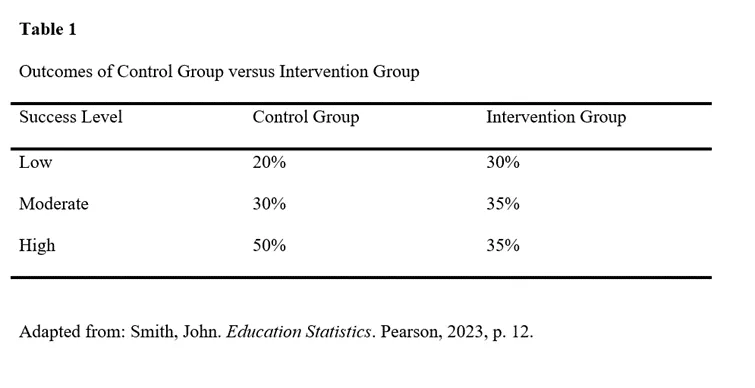
MLA Format Essay Examples
- Ayn Rand’s Anthem: Individualism and Language
- Cultural Identity: Problems, Coping, and Outcomes
- Donald Trump: His Political Course and Contribution as a President
- Flowers for Algernon by Daniel Keyes
- George Washington: Biography and Achievements
- GMO Production: Reasons and Potential Effects
- Handling Cyberbullying in the 21st Century
- Jerome Salinger’s The Catcher in the Rye
- Legalizing Marijuana: Pros and Cons
- Procrastination and its Causes
- Siddhartha by Hermann Hesse
- Study Abroad Specifics
- The Book Thief: In the Third Reich, Words and Regular People Matter
- The Gift of the Magi by O. Henry
- The Giver: The Flawed “Flawless” World
- The Glass Castle by Jeannette Walls
- The Glass Menagerie by Tennessee Williams
- The Life and Work of Mother Teresa
- The Mulatto by Victor Sejour: The Critique of the Slave-Owning Society
- The Problem of Overpopulation
- The Relation between Eliezer and His Father in Night by Elie Wiesel
- Their Eyes Were Watching God: Summary, Main Themes, and Evaluation
- Tuesdays with Morrie by Mitch Albom
- Violence in Video Games